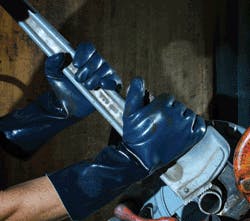"Can I give you a hand with that?" When I hear this always-welcome offer to lend assistance, I breathe a sigh of relief, knowing that help has arrived. Hands truly are helpful, and it's no surprise to me that the hands were the part of the human anatomy selected over all other parts to mean the same thing as "help" in this often-recited question.
Here's another popular phrase that uses hands to symbolize praise: "Congratulations, let's give him/her a hand!" In this call for a congratulatory gesture, "hand" symbolizes an expression of approval in the form of applause. Who doesn't like to be given a hand (i.e., applause)? Clapping hands create a delightful noise that we're taught from an early age to respond to with encouraging satisfaction. Clap for a little baby and you'll see my point.
Our hands are so versatile and play such an important role in our day-to-day lives. It's no wonder that the familiar phrase "I've got to hand it to you” assigns the hand the important responsibility of symbolizing credit. You've got to hand it to the hands: They are handy. With all these positive symbols we assign to our hands, you can't deny that hands are important, right?
Yet, despite all of our hands' importance, it's ironic that we habitually place our hands in danger. Think about it: We instinctively throw our hands out in front of us to absorb the on-coming crash when we trip and fall, protecting our bodies from the impact. Additionally, when we feel angry or threatened, we ball up our hands into tight fists and use them to defend or protect ourselves.
Despite our hands' helpfulness, praiseworthiness, distinction, usefulness and overall importance, we first think to place our hands in harm's way. After all, our ears, toes or neck don't offer nearly the same protection that our hands dutifully provide. The fact that we use our hands to shield us from threats of all kind further supports the overall usefulness of this irreplaceable anatomical tool.
It's no wonder that from a young age, children are taught about the grand significance of hands. I remember that my daughter learned a preschool song about hands that she sang for weeks. Sadly, she doesn't sing that cheerful song anymore. Just like my daughter eventually forgot the hand song, people at some point begin to disregard hands and fail to take proper care of them. Some even go so far as to inadequately protect their hands at work, which sometimes results in injury.
Getting a Handle on Hand Injuries
In a recent conversation with David Lynn, vice president of Signature Services at Life and Safety Consultants and a former OSHA compliance officer, he noted that in his 20 years evaluating workplace safety, hand injuries comprised close to half of the cases he investigated and without question, all of them were preventable.
The National Safety Council (NSC) reported in the 2013 Injury Facts that injuries to the hands (wrist and fingers included) represent 16.5 percent of all workplace injuries in 2010. Andy Johnson, executive vice president of risk control services at Captive Resources (CRI), the largest member-owned group captive insurance company in the United States, reports that the average cost of an injury to the hand is $3,700. So, hand injuries occur often and cost a lot of money!
Now folks, let's not lose our grip on safety here! NSC and CRI report alarming quantitative data about hand injuries, but did you catch what Lynn said: All hand injuries are preventable. And when I talk about hand safety, I include the wrist and fingers in the equation.
Like many other safety-related programs, a proper hand-safety program should include hazard analysis, awareness training, assessment and periodic evaluation of the program – all necessary and important elements. But how does an organization deliver a hand-safety program that garners management commitment and, more importantly, inspires the folks turning the wrenches and operating the machines to pay attention to hand safety?
Accountability and periodic review and evaluation are a must, but those elements may not inspire the masses. A worthwhile hand-safety program should offer inspiration equal to the greatness of the amazing appendages that are our hands! We need a program worthy to be considered "hands-on” that will protect the hands that labor in the workplace trenches. The best programs teach employees how the entire body effects hand safety and leverage mental awareness of the hands and the causes of hand injuries.
Hand Tools and PPE
Once management has invested in a hand-safety program and cleared the way for a peer-to-peer-driven program, the next step is to ensure proper hand-safety resources are applied. These resources include personal protective equipment (PPE) for hands, hand-tool selection and maintenance and a substantial safety evaluation method.
PPE is a critical element of hand safety but should not comprise your entire hand-safety program. Deciding upon the most ideal PPE to protect hands from hazards is an important last protection that falls behind hazard elimination, policy and guarding the hazard all together. A word of warning: PPE for hands that is doled out thoughtlessly but with good intention can be a problem disguised as a solution. For example, the wrong-size gloves may protect the hands from the apparent hazard like heat or sharp edges but if they don't fit properly, they may reduce dexterity, grip and a multitude of other possible issues. Hand protection carefully should be matched to the hazard and accurately sized to fit the hand it protects.
Not all hand tools are created equal. With that notion in mind, select the tool that offers the best protection for the hands, train employees to correctly use the tool and take special care to keep the tool in tip-top shape. Like our hands, hand tools often are thrust into harm's way to get the job done, resulting in wear and tear.
For this reason, it is a wise practice to institute regular inspections of tools to identify hazards like sharp edges and worn-out insulation that occur due to normal use. Too often, we use hand tools that are damaged past the point of safe condition. It's easy to spot wear and tear on a tool like broken or cracked parts, dull blades and other deterioration due to normal handling and use, but we if never take time to inspect the tools, employees' hands may be injured by damaged tools.
How we use our hand tools also is important; not all tools our hands use are created equal, especially ergonomically speaking. Truth be told, employees often incorrectly use the hand tools that are brilliantly designed for task comfort when used in the correct way. It's best if tool use is monitored with a behavior-based evaluation. In this way, through evaluation, over-use-type injuries due to misuse of the hand tool can be identified and corrected.
There are many observation tools available that help evaluators pinpoint ergonomic hazards; in fact, OSHA offers several on its web site, http://www.osha.org. The key is to create a process that includes regular evaluation followed by coaching. All the brilliant and careful design that goes into creating an ergonomically amazing hand tool is wasted if it is not used appropriately and as designed.
Hand safety doesn't have to be hard to handle. With a great hand-safety program and proper hand PPE, safety professionals will be well on their way to rooting out hazard from the workplace. How about a round of applause for hand safety!


